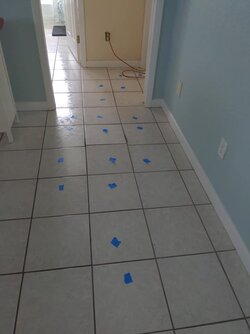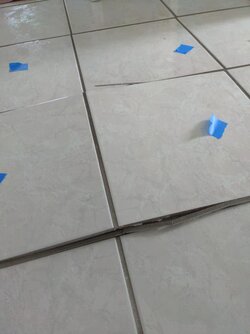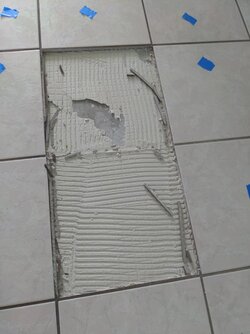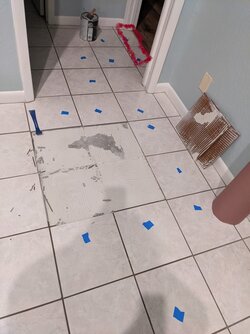Hi, I've put down quite a bit of tile over the years but always worked with backerboard. I'm renovating a house in Florida (first one in Florida) that was built in 1996. It's concrete slab foundation and the tile was laid directly on the slab with what appears to be basic thinset.
When I was taking up old laminate, I cracked the seal on two tiles at the threshhold. I tucked that away in my mind as something I needed to address and kept working on other things. The other night I was awakened by a series of loud cracks. I discovered that a couple of the tiles near the two I'd disrupted were tented. Stepping on the tiles around them I could tell that a number of them had popped. The floor underneath looks normal, there doesn't seem to be moisture. If anything, it looks like the grout may not have been wet enough when the tiles were installed.
My plan is to remove the popped tiles, redguard the area and reset using thinset. But I'm concerned that it seems to be a regional failure in the field. I came here hoping to find someone with more experience with this substraight who might be able to advise me on what is going on. I am hoping that its just an area where the thinset was not wet enough and they didn't wet the back of the tile to help adhere them. There are a couple of other hollow sounding tile in the field, which is about 1000 sq ft total. I would prefer not to rip it all up right now unless there is a compelling reason. Appreciate your insight and help.
When I was taking up old laminate, I cracked the seal on two tiles at the threshhold. I tucked that away in my mind as something I needed to address and kept working on other things. The other night I was awakened by a series of loud cracks. I discovered that a couple of the tiles near the two I'd disrupted were tented. Stepping on the tiles around them I could tell that a number of them had popped. The floor underneath looks normal, there doesn't seem to be moisture. If anything, it looks like the grout may not have been wet enough when the tiles were installed.
My plan is to remove the popped tiles, redguard the area and reset using thinset. But I'm concerned that it seems to be a regional failure in the field. I came here hoping to find someone with more experience with this substraight who might be able to advise me on what is going on. I am hoping that its just an area where the thinset was not wet enough and they didn't wet the back of the tile to help adhere them. There are a couple of other hollow sounding tile in the field, which is about 1000 sq ft total. I would prefer not to rip it all up right now unless there is a compelling reason. Appreciate your insight and help.




